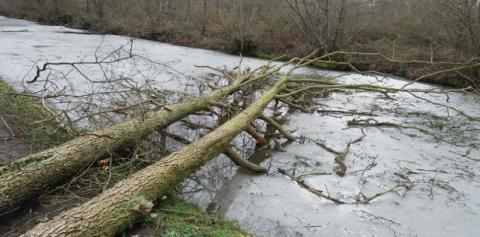C&RT ISSUES THREATS TO AVOID ANSWERING QUESTIONS
August 2018 - Asked to explain discrepancies within its own figures on canal closures, Canal and River Trust’s head of legal services claimed answering the questions, from The Floater’s Allan Richards, would cause: “harassment of, or distress to, the public authorities staff'. He added 'We do reserve the right to bring this behaviour to the attention of the relevant authorities for the purposes of the Protection from Harassment Act 1997”
It was two months ago that The Floater brought to the attention of the public the high number of unscheduled stoppages on C&RT's waterways. A snapshot taken on 13 June found no less than 13 'Emergency Navigation Closures' in force with a surprising number closed until further notice (CLOSED - until further notice). Daily monitoring of unscheduled stoppages over the two months since that article has shown the situation unimproved, with daily recordings always between a low of 11 and a high of 16. Allan Richards has taken look and wonders if C&RT's performance measures regarding closures are deliberately misleading.
At the time of writing , the situation is slightly worse due to what C&RT's hydrologists call 'navigational drought'. The figure on 13 August is slightly up on two months ago with 15 emergency navigation closures showing on C&RT's stoppages database. Whilst the C&RT publicity machine claims that 95% of its system remains open, the sad fact is that that many can't get to the parts of the system that they want to access, companies are losing business and peoples holidays have been ruined.
Let's start with one of C&RT's two closure measures. C&RT are required, as part of its Grant Agreement with Defra, to provide 'publication data' on or before 1 July each year. Schedule 5 of the Grant Agreement provides that, relating to footpaths [i.e. towpaths], C&RT must publish 'the number and duration of unplanned closures'. 'Publication data' for C&RT's 2017/18 financial year is contained in pages 48 and 49 of its annual report.
The publication data defines unplanned towpath closures as those 'caused by asset or infrastructure failure'. It gives the 2017/18 number of closures as 31 (2016/17: 24) and number of closure days as 452 (2016/17: 294). That's a steep rise in both the number of closures (29%) and the number of closure days (54%).
It may come as a surprise to some but there is no requirement under the Grant Agreement to publish the same information relating to navigational closures. C&RT takes advantage of this and does not publish figures for the number of navigation closures. It does, however, publish figures relating to navigation closure days. It's 2017/18 annual report gives the figure as 490 days against a target of of 400 with the previous year given as 549. A casual reader might be forgiven for thinking that, whilst C&RT had missed its 2018/19 target by a country mile, at least it managed a decrease against the previous year. Sad to say, however, these figures come straight from C&RT's department of dodgy statistics.
Consider this. As stated above, the number of navigational closures monitored over an eight week period has never fallen below 11. If this were extrapolated over a year then it would equate to over 4,000 days of closure. Even if we took out the five months of winter works with all its planed closures we would still be left with a figure of over well over 2,000 navigation closure days. This is four or even five times higher than the figure given in the annual report.
So has the number of navigation closure days suddenly shot up? Well C&RT's annual report claims it has significantly reduced unplanned closures since its formation -
'Notwithstanding our rising core expenditure and our improving application of the principles of long term asset management as our asset strategy evolves, the considerable age of our infrastructure, much over two centuries old, means that we do suffer significant asset failures that require immediate intervention. Lock 15 on the Peak Forest Canal’s Marple flight had to be closed in September 2017 after a lock wall was found to have moved such that the lock had become un-usable. This was a significant factor in us missing our target on unplanned closures in the year, (with 490 days lost against the target of 400, though this remains a significant improvement since the Trust was created).'
No mention, of course, that the Marple flight opened but closed again a few days later due to a similar problem at another lock on the flight.
However, we digress! Perhaps a clue lies in C&RT mentioning Lock 15 being closed for six or seven months of last financial year. That's about 200 days. Looking at current closures, it can be determined that Stainton Aqueduct was closed for 365 days in 2017/18. Three Mills Lock was closed on 16 October 2017 and is still closed. That means it was closed for 167 days during 2017/18. Middlewood locks on the Manchester, Bury & Bolton Canal has been closed since 30 July 2017 - that's another 245 days
A bit of adding up: 200+365+167+245=977. As can be seen, we are already double the number of navigation closure days that C&RT is declaring just on four closures.
Fairly obviously, C&RT is dramatically under reporting navigational closures. Reading its last two annual reports shows how it is doing this. It's 2016/17 annual report gives 'unplanned navigation closures' as 549. Its latest annual report spills the beans by declaring that the same figure (549) is actually the 'number of days of unplanned navigation closures within our control (individual instances over 48hrs)'.
So what C&RT has previously told us is 'unplanned closures' does not include short term closures of less than 48 hours. Trees falling and blocking the cut often result in closures of less than 48 hours but would not be included. The overnight closures we are now to experiencing due to a need to conserve water would not be included.
... and what does 'within our control' mean? Does it have something to do with C&RT's eagerness to brand infrastructure failures as being the fault of vandals and boaters? Are the current closures due to navigational drought 'within our control'?
The problem is, of course, that C&RT gives itself the flexibility to exclude any closure that would make its figures look bad. Take, for example, the Grade II listed Stainton Aqueduct. Both C&RT and EA were informed in 2014 of its instability despite work carried out volunteers to prevent erosion of its base by the river which had changed course. C&RT did nothing. It now claims the aqueduct was in good condition and blames the closure on storms Desmond and Eva in December 2015.
Assuming the closure is lifted some time in 2019, blaming Desmond will allow C&RT to exclude over 1,000 days from its figures over a four year period. Of course, whilst C&RT might argue that the structual failure is not 'within our control', it can hardly make the same claim regarding the length of the closure! It has taken a decision not to commence work rebuilding the aqueduct preferring to spend years obtaining third party funding. That is very much 'within our control'.
Whilst Stainton is perhaps an extreme example, it is obvious that C&RT is deliberately misrepresenting the number of days of navigational closure such that it can show an improvement.
On 11 July, C&RT were provided with a list of the 16 navigation closures showing on its stoppage database for that day -
- Lock 7, Actons Lock, Regents Canal
- Lock 1 to 12. Macclesfield Canal.
- Lock 2, Belan Locks, Montgomery Canal
- Teeces Bridge (Stoney Lane Little Bloxwich) Wyrley & Essington Canal
- Lock 4, Aston, Birmingham & Fazeley Canal
- Trent & Mersey, Lock 62, Pavilion Lock and Lock 67 Booth Lane Top Lock
- Camp Hill Top Lock to Knowle Top Lock
- Glasson Flight - Lancaster Canal
- Bridge 46 Bevans Lane Bridge (Mon & Brec) »
- Bridge 10 (Holmes Swing Bridge) to Stanley Lock Flight / Eldonian Village (Leeds & Liverpool)
- Marsh Lock, Weaver Navigation/Manchester Ship Canal
- Lock 11 Peak Forest Canal, Marple
- Stanthorne Lock to Wardle Lock
- Three Mills Lock
- Manchester, Bury & Bolton Canal (Middlewood Locks)
- Stainton Aqueduct - Lancaster Canal
The Trust was asked which of the these unscheduled closures they considered to be 'within our control'.
C&RT were also asked to provide navigational closure figures for 2017/2018 using the same criteria used for towpath closures.
C&RT's response was to delay for three weeks and then claim that asking for such information was vexatious. A letter from Tom Deards, Head of Legal & Governance Services explains that providing the information would cause 'harassment of, or distress to, the public authorities staff'. He added 'We do reserve the right to bring this behaviour to the attention of the relevant authorities for the purposes of the Protection from Harassment Act 1997.'
Should we be more concerned with the threat of legal action or the fact that C&RT's Head of Legal & Governance Services seems unaware that C&RT is a charity and not a public authority any more?
Photos: (1st) Tom Deards, Head of Legal & Governance Services for Canal & River Trust, (2nd) Annual Report 2016/17, (3rd) Annual Report 2017-18, (4th) Closures of less than 48 hours, like those caused by fallen trees are not included.









